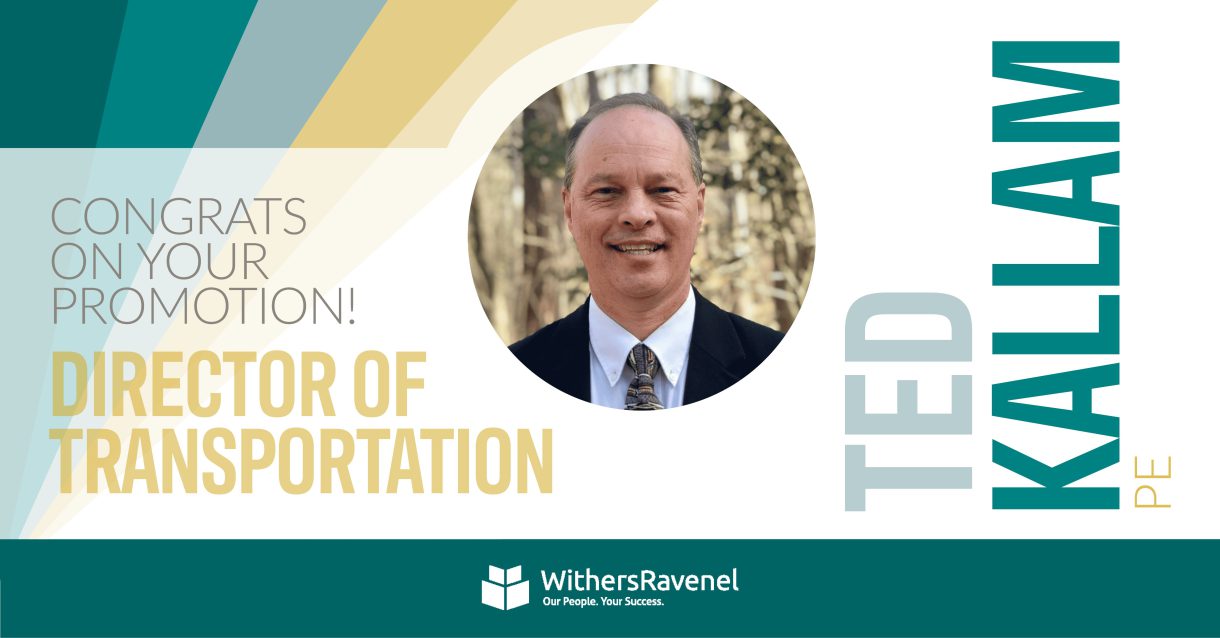
WithersRavenel has tapped Client Success Manager Ted Kallam to lead a new Transportation Department within the firm.
Ted joined WithersRavenel in March 2020 to help our public sector on-call clients solve complex engineering problems. As the Client Success Manager for the City of Greensboro, he provides the City with technical expertise, customized solutions, and a holistic view of the City’s projects.
I caught up with Ted to find out more about what the new department is working on, how they interface with other teams in the company, and what’s on the horizon for transportation projects in 2021.
Caitlyn Myers: Congratulations on your promotion! Launching a Transportation Department has been a goal at WithersRavenel for some time, and it’s great to see that take shape. What kinds of projects will your team be tackling?
Ted Kallam: The primary focus areas are roadway design and pavement management services. Roadway design encompasses pavement widening, sidewalks, curb and gutter, and greenways, along with their corresponding water, sewer, and other utility impacts. Pavement management services include rating the asphalt to determine its current deterioration level and recommending the type of improvement needed.
CM: ADA compliance is a topic that seems to be coming up a lot more lately. Why now?
TK: The U.S. Department of Justice is responsible for implementing the regulations of the Americans with Disabilities Act. Public agencies have been instructed to bring their infrastructure into compliance or risk the loss of federal transportation funding. An ADA Assessment and Transition Plan allows the municipality to meet the guidelines.
CM: What do clients need to know so they can avoid the loss of federal transportation funding?
TK: There’s a two-pronged approach for handling ADA compliance. The first step is performing a self-evaluation, where the local government reviews all of its ADA-regulated facilities and determines what needs to be fixed. The second step is creating a transition plan, which outlines how to address those problems, what it’s estimated to cost, and who’s responsible for overseeing the improvement process. WithersRavenel has a template for performing ADA self-assessments and preparing transition plans, and it’s helped multiple clients like the Town of Weaverville get a handle on their needs.
CM: Inventorying every ramp, doorway, and stairwell sounds pretty daunting, to say nothing of the miles and miles of sidewalks and trails. How do you keep track of it all?
TK: We work closely with the GIS team to manage field data collection and flow everything into a GIS database. Using tools like ArcGIS and schemas like the Local Government Information Model and Utility Data Model, we make sure clients know where their assets are, how they’re interconnected, and what condition they’re in. If the client has a work order system for maintenance and repairs, we can link it to the GIS data so that staff can see when assets are repaired or replaced.
We’ve also started collaborating with the Funding & Asset Management team. Together, our areas of expertise synergize to create a complete picture of the asset life cycle. With modeling tools like AgileAssets and Capital Predictor¢, the Asset Management team can take the information we provide about roadway material, age, and wear patterns and predict when each segment will need to be repaved. The Funding team builds off that to figure out what those repaving projects will cost, and how to fit them into an existing budget or modify a future budget to account for those needs.
CM: Can you do that for any transportation network?
TK: Absolutely. We’ve helped municipalities ranging from 20 centerline miles to 1,000 centerline miles. No project is too big or too small.
CM: That’s remarkable. It’s like getting a glimpse into the future. What else do you see when you look into your transportation crystal ball?
TK: If you remember the push for walkable, livable communities, then the desire for walkable, livable streets is a natural evolution of that. More and more communities are asking for bike lanes, sidewalks, and pocket parks many times on the same street segment. These features make it easier for individuals and families to decrease their carbon footprint and increase their activity levels and socialization.
CM: One of the things I love about North Carolina is the emphasis on outdoors spaces. Are there any challenges to creating these walkable, livable streets?
TK: Public education is very important. Wish list items have to be balanced against budget and space constraints, and sometimes certain amenities just aren’t feasible within those parameters. Other features may be affordable to build, but prohibitively expensive to maintain. Communicating all of that to stakeholders, particularly the community that will be served by the project, is key to achieving satisfaction.
CM: Budgets are always a challenge. Does funding exist for transportation projects?
TK: Limited funding does exist. While we have seen funding availability decline in the last year or two, it also tends to reflect the overall state of the economy. As the economy begins to strengthen, funding availability should improve again. But regardless of whether things are up or down, we can help clients build a data-driven case to justify their funding needs, and then apply for and manage funds for their projects.
CM: That’s very exciting. Thank you so much for sharing your insights, and we look forward to seeing how the Transportation Department evolves in the coming year!
Readers, please join me in congratulating Ted Kallam on his new role. If you have a transportation project on the horizon or want to know where to start when it comes to managing your transportation assets, you can reach out to Ted at (919) 238-0363 or tkallam@withersravenel.com.
